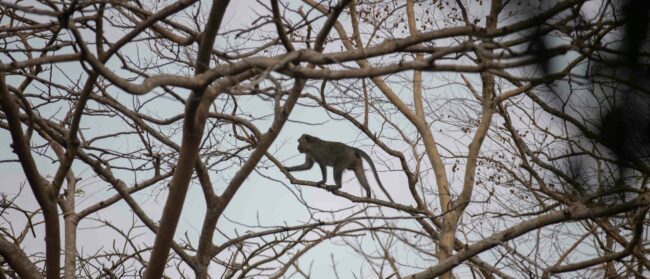The kouprey’s near-mythical existence was still being questioned up until 2006. Considered one of the greatest large mammal discoveries by science in the 20th century, the critically endangered wild cattle species is shrouded in mystery.
The kouprey was given the title of Cambodia’s national mammal in a 2005 royal decree, alongside other animal designations including the Giant Ibis as national bird, Royal Turtle as national reptile, Giant Mekong Barb as national fish, sugar palm as national tree, rumdul as national flower and chicken egg banana as national fruit.
Science discovered the kouprey in a Parisian zoo in 1937, after a veterinarian in Cambodia sent over a captured calf from Preah Vihear. Kouprey, which in the Khmer language means ‘Forest Ox’ or ‘Grey Ox,’ is known for its tall, narrow body, long legs, crest-shaped horns and humped back.
The most recent kouprey news came wrapped in a controversy.
A now-disproven study caused a stir in 2006 by claiming the kouprey never existed as a natural wild species, asserting the animal was a hybrid between domestic cattle and the endangered banteng. The following year, another study rejected that claim with more evidence pointing towards the kouprey’s unique existence.
“There’s no doubt in my mind that kouprey was a valid species, as distinct a species as banteng or gaur,” said Robert Timmins, a member of the Asian Wild Cattle Specialist Group within the International Union for the Conservation of Nature (IUCN).
Doubts about the kouprey’s true identity nearly 70 years after discovery only added to the mystery around the mythic species.
Most of the known ecological data about the kouprey was recorded during an expedition to Preah Vihear province in the 1960s, which set out hoping to find, capture and study the kouprey. Only the latter goal was accomplished. The last confirmed kouprey sighting was in Cambodia at the end of the 1960s.
In 1996, the kouprey was elevated from ‘endangered’ to ‘critically endangered’ on the IUCN’s Red List of threatened species.

“At the turn of the century, it was already looking like kouprey were functionally extinct,” said Timmins, the lead author of the most recent species assessment. “Maybe there could have been a few individuals still in the forest, but for those individuals to be alive today it would mean those animals had incredibly long lifespans in the wild, which is not a reasonable scientific assumption.”
Overhunting is considered a main factor in the decline of the species. Field studies found male and female kouprey horns sold for several thousand U.S. dollars in the illegal wildlife trade.
The species assessment states “it is unlikely that specific survey work for Kouprey would produce any better evidence than has already been documented,” suggesting conservation efforts instead focus on protecting large mammal habitat in eastern Cambodia.
“You’ve got finite resources for conservation. Unless you protect the habitat, even if you find those few animals, you’re not going to be able to protect them,” Timmins said. “It is an unfortunate but real conservation dilemma in most of Southeast Asia.”
This article is part of Southeast Asia Globe’s World Wildlife Day Special series.


